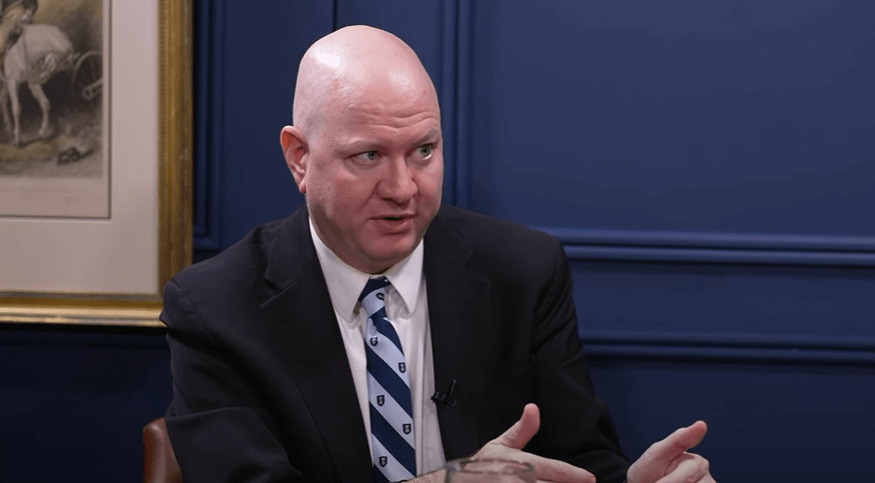American Secession:
The Looming Threat of a National Breakup
By F. H. Buckley
(Encounter Books, 2020)
California governor Gavin Newsom recently called his state “a nation-state.” Rhode Island governor Gina Raimondo shut down the borders to out-of-state travelers and sicced the state police on New Yorkers hiding out in their second homes. The COVID-19 pandemic has shown us just how institutionally robust state governments are and how disconnected the United States can become.
Enter American Secession. Canadian-born George Mason University law professor Frank Buckley has of late made a career out of criticizing the failures of American legal and political institutions. With this book he comes close to throwing in the towel altogether. Following work as editor of a scholarly volume on the shortcomings and irrationalities of U.S. tort law and as author of a carefully researched polemic against American presidentialism, Buckley now has brought forth perhaps the highest-profile call for considering disuniting the states since the 1860s.
Short and readable, American Secession aims at a mainstream audience. How well does it persuade?
The book takes three main lines of argument. First, Buckley argues that secession would be constitutional, and that, more importantly, the federal government is unlikely to stop any state that seriously tries to secede. Second, the book tries to show that Americans would be better off as citizens of smaller countries; the United States is simply too large. Third, the book claims that partisan and ideological polarization, particularly what political scientists call affective polarization, is driving the U.S. toward disintegration. The first line of argument comes out looking strongest.
Buckley argues persuasively that an originalist understanding of the U.S. Constitution would find state secession from the Union to be constitutionally permissible. The federal design of the Constitution resembles not James Madison’s Virginia Plan but the decentralist aims of Roger Sherman and others, rooted in compact theory (what the states made, they may dissolve). The Articles of Confederation’s promise of “perpetual union” is not good law. And the Supreme Court’s Texas v. White decision that the Constitution’s stated purpose of a “more perfect Union” implies indissolubility begs the question. After all, is a more perfect Union consistent with a ban on secession or, instead, a theory of voluntary compact?
Buckley mentions the state ratification conventions’ assertions of sovereignty. He could also have mentioned that New Hampshire’s constitution, enacted before the U.S. Constitution and never amended, explicitly affirms a right of secession:
The people of this state have the sole and exclusive right of governing themselves as a free, sovereign, and independent state; and do, and forever hereafter shall, exercise and enjoy every power, jurisdiction, and right, pertaining thereto, which is not, or may not hereafter be, by them expressly delegated to the United States of America in congress assembled. [Emphasis added.]
Even under Texas v. White, however, it is not clear that secession would require a constitutional amendment. (Buckley imagines this happening through a constitutional convention called by the states.) Even if secession is not a constitutionally reserved power of each state, it could be within the powers of Congress to permit it.
Politically, too, it is hard to imagine that the federal government would pursue the Slobodan Milošević route to suppress secession by force. Still, one could see a U.S. president attempting what Spain recently did in Catalonia with overwhelming police presence and targeted arrests and prosecutions of political and civic leaders. But Spain has a more robust, militarized national police capability than does the U.S. federal government.
Like the late Thomas Naylor, the Duke economics professor who moved to Vermont and founded an independence movement, Buckley believes that bigness breeds badness. People in smaller countries tend to be happier, freer, and more prosperous. Smaller countries are less corrupt and have smaller militaries.
The correlational analyses that Buckley undertakes to establish these points are suggestive, but they would not persuade a social scientist. Which way does causality run? Buckley observes that authoritarian states are more likely to try to be big: China annexed Tibet and the USSR annexed the Baltics even as the democratic states of Western Europe began to liberate their colonial possessions. But the fact that bigger states tend to be less free does not establish that Americans would be freer if only they broke up.
If dictatorships make people less happy, moreover, then people in smaller states might be happier not because of smallness per se but because they tend not to live under dictatorships that try to be big. A selection effect could account for why smaller states are richer: the only small peoples that are able to win and defend their independence are likely to be rich ones. Poor small peoples never enter the dataset as independent states.
Furthermore, one can easily think of small states that are nightmarish hellholes, like Equatorial Guinea. Surely the women and girls of Pitcairn Island, who suffered decades of sexual abuse, would have been better off in a larger, more connected society. Smallness combined with isolation or an illiberal regime might be especially harmful.
Buckley is on stronger ground in arguing that affective polarization lays the groundwork for a future secession movement. If liberal Californians or conservative Texans feel hated and downtrodden by the rest of the country, they could have a reason to seek independence. My own research finds that more “ideologically distinctive” regions tend to host stronger secessionist movements.
Still, conservatism is not a nationality. Left-right polarization undermines secessionism in another way, by steamrolling state idiosyncrasies in civic culture. The more we can read off a state’s political interest from its typical two-party presidential vote share, the less distinctive is that state’s political culture, and the more strategic and cynical any secession movement is likely to seem. Note further that ideologically motivated secessionism is always more prevalent among the federal out-party in the United States. Thus the set of circumstances under which a state wants to secede and the federal government is sufficiently sympathetic to let it go makes for a narrow window indeed.
States’ Rights, States’ Autonomy
In the end, Buckley pulls back from endorsing secession and declares himself a unionist. He contends that “secession lite” is a more feasible path forward. What he means by the term is a kind of “home rule” that would serve as an alternative to federalism. Motivated by the example of Canada’s evolving status within Britain in the nineteenth and early twentieth centuries, Buckley says that the federal government could offer more autonomy to the states by cutting federal regulation and even allowing them to gain opt-outs from certain portions of the Bill of Rights, as Canadian provinces currently enjoy through the “notwithstanding” clause in the Charter of Rights and Freedoms.
Buckley is right that U.S. federalism no longer meets its potential. But he misses an opportunity to identify the true obstacle to solving that problem. Reducing federal regulation so that states can handle policy problems in their own way has always been an option. Debates in Congress right now about whether the federal government should reduce or increase regulation on, say, health insurance or drug approvals are nothing more than debates about whether states should be free to have different systems. After all, there is nothing, constitutionally speaking, preventing states from enacting their own food and drug regulations or health insurance regulations, provided Congress hasn’t preempted them.
But to ask congresspeople to exercise restraint and forgo opportunities to boost their standing among partisan constituencies by touting their legislative accomplishments is naive. If Congress can do something to be more popular, it will, “home rule” be damned. The ideological antipathies and political incentives that felled classical American federalism are the very ones that could block home rule à la Buckley.
Still, home rule might have promise if it were enacted asymmetrically. Americans are not used to thinking of federalism as having any potential for asymmetric autonomy across states. But this is the usual situation in the rest of the world. I have tried to persuade activists in New Hampshire’s independence movement to consider “self-government” as an alternative to independence. Self-government could mean that Congress simply exempts New Hampshire from a swath of federal regulations and programs and gives the state back “tax points” to run its own programs. Then politicians can still take the credit for enacting sweeping national laws to “solve” problems, but little New Hampshire can, under the radar, go its own way.
In the limit case, a state could aim for a Compact of Free Association like that between the Marshall Islands and the United States. Free association entails formal independence, but the U.S. sets foreign and defense policy for the territory. Does New Hampshire really need its own military and diplomatic corps? Presumably not.
What are the future circumstances under which the U.S. might break up? Rather than affective polarization, ideological polarization of the parties combined with U.S. federal institutions could do the trick. Already it has become extraordinarily difficult for Congress to enact new legislation under divided government. Spending money is, however, a bipartisan pastime, and federal debt as a share of the economy is higher than ever, leaving less room for future spending.
Imagine a generation hence when the federal government’s legislative and enforcement capacity has been hollowed out, leaving states as the main actors in dealing with the economic, social, cultural, and, yes, epidemiological challenges of the future. The federal government’s massive regulatory and distributive apparatuses remain, hulking and rusting, but they can no longer impose their will on private actors. The United States of that scenario looks like the Yugoslavia or Soviet Union of 1991.
Marijuana legalization has become an important issue at the state level precisely because the federal government lacks the capacity to enforce its own laws. What happens when, due to rising debt and the fiscal burden of writing checks to the elderly, infirm, and foreign central banks, the U.S. government lacks the resources to hire agents to enforce federal banking and securities law, food and drug regulations, immigration law, and eventually, perhaps, taxation itself? The states become more and more de facto independent, filling the gaps left behind as they will. And if some day one of them chooses to push over the tottering heap with a formal declaration, it will simply ratify what will have long since become citizens’ lived reality. Little of this is an outcome to be wished for, but it is nonetheless easy to imagine.
With any luck, American Secession will spur a debate about state autonomy in the U.S. Read this book for a clear-eyed analysis of the costs and benefits of breaking up the country. Secession should be a thinkable thought. We might all be better off for it.
Jason Sorens is director of the Center for Ethics in Business and Governance at Saint Anselm College and author of Secessionism: Identity, Interest, and Strategy.














